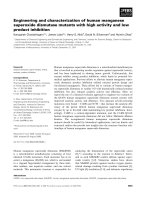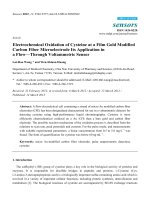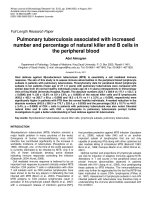Synthesis of near infrared cyanine dye library with increased photostability and its application in fluorescence and SERS imaging
Bạn đang xem bản rút gọn của tài liệu. Xem và tải ngay bản đầy đủ của tài liệu tại đây (7.13 MB, 217 trang )
SYNTHESIS OF NEAR-INFRARED CYANINE DYE LIBRARY
WITH INCREASED PHOTOSTABILITY AND ITS
APPLICATION IN FLUORESCENCE AND SERS IMAGING
ANIMESH SAMANTA
(M. Sc., Indian Institute of Technology Madras, Chennai, India)
A THESIS SUMBITTED
FOR THE DEGREE OF DOCTOR OF PHILOSOPHY
DEPARTMENT OF CHEMISTRY
NATIONAL UNIVERSITY OF SINGAPORE
2012
II
ACKNOWLEDGEMENTS
I would like to express my most sincere gratitude to my supervisor, Associate
Professor Young-Tae Chang for his most valuable guidance, great support, lots of
patience and endless encouragement during the last four years. His motivation always
helped me to learn new things in the scientific field and to overcome difficult challenges.
I would also like to express my sincere gratitude to Dr. Marc Vendrell for his
great support, guidance and continuous help for each and every moment. There are no
sufficient words to express my gratitude to him. He did not only teach me research
guidance but also to be a man. My sincere appreciation also goes to Dr. Kaustabh Kumar
Maiti for his kind support, valuable guidance and continuous encouragement.
My sincere appreciation goes to all past and present members of our lab whose
contribution made this journey really enjoyable in each and every step of my research
life.
Words are insufficient to express my sincere thanks for being such helpful and
cooperative lab-mates to Dr. Yun Seong Wook and others, specially Dr. Kang Nam-
Young, Dr. Sung Chan Lee, Dr. Ha Hyung-Ho, Dr. Jun-Seok Lee, Dr. Yun-Kyung Kim,
Dr. Kim Hanjo, Feng Suihan, Kelly, Dr. Sung Jin Park, Dr. Junyoung Kim, Dr. Woo Sirl
Lee, Dr. Satoshi Arai, Dr. Li Xin, Dr. Yoo Jung Sun, Dr. Jiyeon Ock, Dr. Kim Jinmi, Dr.
Taslima Khanam, Dr. Teoh Chai Lean, Chang Liang, Dr. Kale, Duanting, Dongdong, Xu
Wang, Samira, MyungWon, Yoges, Emmiline, Jow Zhi Yen, Chee Geng, Physilia,
Jimmy, Pamela, Fronia, Tang Mui Kee and Xiaojun Liao.
My special thanks go to Raj Kumar, Krishna Kanta, Bikram and Sanjay to make
me so happy in my lab during my benchwork. These memorable days will remain as a
sweet memory forever.
III
I would like to thank Dr. Malini Olivo and Dr. Qing-Hua Xu for allowing me to
use their instrument facilities. I also thank the supportive hands to complete my project
works to Dr. U.S. Dinish, Dr. Junho Chung, Zhenping Guan, Kiat-Seng Soh, Dr.
Ramaswamy Bhuvaneswari, Dr. Hyori Kim, Dr. Shashi Rautela.
I take this opportunity to thank all of my friends and juniors who helped my
dreams come true. I am thankful to Tanay, Mainakda, Pasarida, Gautam, Pradipta,
Kausik, Sadanandada, Amarenduda, Subhankar, Srimanta, Asim, Hriday, Sudiptada,
Sabyasachi, Nimai, Bijay and Jhinukdi who made my stay at NUS so pleasant.
Financial and technical support from the Department of Chemistry of the
National University of Singapore (NUS) is greatly acknowledged. I would like to thank
all the staffs in chemistry administrative office, Lab-supplies for their immense support.
Finally, I would like to express my deepest gratitude towards my parents, my
brother, sister, brother in-law, all my relatives and soma. I think that without their
continuous support and constant inspiration this thesis would not have been completed.
At last I would like to heartily thank God for giving me the patience, faith and strength to
complete my thesis.
IV
Thesis Declaration
The work in this thesis is the original work of Animesh Samanta, performed
independently under the supervision of Associate Professor Young Tae Chang, (in the
laboratory LuminoGenomics, S9-03-03), Chemistry Department, National University of
Singapore, between 09/01/2008 and 08/01/2012.
The content of the thesis has been partly published in:
1) Development of photostable near-IR cyanine dyes, Samanta, A.; Vendrell, M.;
Das, R.; Chang, Y. T.* Chem. Commun., 2010, 46, 7406-7408.
2) A Photostable Near-Infrared Protein Labeling Dye for in vivo Imaging, Samanta,
A.; Vendrell, M.; Yun, S. W.; Guan, Z.; Xu, Q. H.; Chang, Y. T.* Chem. Asian J.
2011, 6, 1353-1356.
3) Synthesis and Characterization of a Cell-permeable Near-Infrared Fluorescent
Deoxyglucose Analogue for Cancer Cell Imaging, Vendrell, M.; Samanta, A.;
Yun, S. W.; Chang, Y. T.* Org. Biomol. Chem. 2011, 9, 4760-4762.
4) Ultrasensitive Near-Infrared Raman Reporters for SERS-based in vivo Cancer
Detection, Samanta, A.; Maiti, K. K.; Soh, K. S.; Liao, X.; Vendrell, M.; Dinish,
U. S.; Yun, S. W.; Bhuvaneswari, R.; Kim, H.; Rautela, S.; Chung, J.; Olivo, M.;
Chang, Y. T.* Angew. Chem. Int. Ed. Engl., 2011, 50, 6089–6092.
5) Multiplex cancer cell detection by SERS nanotags with cyanine and
triphenylmethine Raman reporters, Maiti K. K.; Samanta, A.; Vendrell, M.; Soh,
K. S.; Olivo, M.; Chang, Y. T.* Chem. Commun., 2011, 47, 3514-3516.
6) SERS-based Multiplex Targeted Detection and Imaging in living mice by
sensitive Near Infrared Raman reporter nanotags, Maiti, K. K.; Dinish, U. S.;
V
Samanta, A.; Soh, K. S.; Vendrell, M.; Yun, S. W.; Olivo, M.; Chang, Y. T.*
submitted to Biosensor Bioelectron.
Animesh Samanta
2012-06-01
Name
Signature
Date
VI
Table of Contents
Acknowledgments
Thesis Declaration
II
IV
Table of contents
VI
Summary
List of Tables
XIII
XV
List of Figures
XVI
List of Charts
XXI
List of Schemes
XXII
Abbreviations and symbols
XXIII
List of publications
XXVI
VII
Chapter 1
Introduction 1
1.1 Overview of fluorophores 1
1.2 Synthetic strategies for novel fluorescent probes 3
1.2.1 Diversity oriented synthesis 3
1.2.2 Target-Oriented Synthesis 5
1.3 Near-infrared fluorophores 6
1.3.1 Cyanine dyes 7
1.3.2 Tricarbocyanine dyes 7
1.4 Properties of cyanine dyes 10
1.4.1 Photophysical properties of cyanine dyes 10
1.4.2 Stability of Cyanine dyes 14
1.4.3. Surface enhanced Raman scattering (SERS) properties 15
1.5 Applications of cyanine dyes 16
1.5.1 In vivo fluorescence imaging 17
1.5.2 SERS imaging 19
1.6 Scope and outline of the thesis 20
1.7 References 22
Chapter 2 Development of photostable near-infrared (NIR) cyanine dyes
2.1 Introduction 30
2.2 Objectives 31
2.3 Results and discussion 31
2.3.1 Decomposition study of tricarbocyanine dye 31
2.3.2 Design and synthesis 34
VIII
2.3.3 Characterization of tricarbocyanine 35
2.3.4 Photostability measurement 36
2.3.5 Library design, characterization and photostability studies 38
2.3.6 Secondary screening and comparative study with ICG 44
2.4 Conclusion 47
2.5 Experimental details 48
2.5.1 Synthesis of CyN and characterization 49
2.5.2 Synthesis of CyNA library and characterization 52
2.5.3 Photostability measurement 55
2.6 References 57
Chapter 3 A Photostable NIR Protein Labeling Dye for In Vivo Imaging
3.1 Introduction 61
3.2 Objectives 61
3.3 Results and discussion 62
3.3.1 Design and synthesis 62
3.3.2 Photophysical properties study 64
3.3.3 Photostability measurement 67
3.3.4 Antibody conjugation and characterization 68
3.3.5 In vitro and in vivo Imaging 70
3.4 Conclusions 72
3.5 Experimental details 73
3.5.1 Synthesis and characterization of CyNE 790 73
3.5.2 Antibody conjugation and characterization 75
3.5.3 Cell Culture and cellular imaging of CyNE790-anti-EGFR in
IX
SCC-15 and MCF-7 cells 75
3.5.4 In vivo imaging 76
3.6 References 78
Chapter 4. Synthesis and Characterization of a Cell-permeable NIR Fluorescent
Deoxyglucose Analogue for Cancer Cell Imaging
4.1 Introduction 81
4.2 Objectives 82
4.3 Results and discussion 82
4.3.1 Design and Synthesis of CyNE 2-DG 82
4.3.2 Cellular uptake and competition assay 83
4.3.3 Comparative cell permeability study with IRDye 800CW 2-DG 88
4.4 Conclusions 90
4.5 Experimental details 91
4.5.1 Synthesis of CyNE 2DG and IRDye 800 2-DG 91
4.5.2 Cell culture and cellular imaging 93
4.6 References 95
Chapter 5. Ultrasensitive NIR Raman Reporters for SERS-Based in vivo Cancer
Detection
5.1 Introduction 98
5.2 Objectives 99
5.3 Results and discussion 100
5.3.1 Design and Synthesis of CyNAMLA library 100
5.3.2 Characterization of CyNAMLA library 103
X
5.3.3 Measurement of SERS 106
5.3.4 Encapsulation of AuNPs and TEM characterization 109
5.3.5 Stability measurement of SERS nanotags 111
5.3.6 Antibody conjugation and SERS study 114
5.3.7 Cell SERS mapping 117
5.3.8 In vivo cancer detection in xenograft mice 119
5.3.10 In vivo SERS imaging 121
5.4 Conclusions 122
5.5 Experimental details 123
5.5.1 Synthesis and Characterization of 4 and CyNAB 123
5.5.2 Synthesis and Characterization of CyNAMLA library 126
5.5.3 Procedures for SERS measurements 129
5.5.4 BSA encapsulation of CyNAMLA-AuNPs and stability studies 129
5.5.5 Procedures for antibody conjugation and TEM Characterization 130
5.5.6 SERS Experiments in cells 131
5.5.7 SERS Mapping in SKBR-3 and MDA-MB231 cells 131
5.5.8 Dark Field microscopy experiments 132
5.5.9 SERS experiments in xenograft mice 132
5.5.10 SERS mapping in xenograft mice 133
5.6 References 134
XI
Chapter 6. Multiplex Cancer Cell Detection by SERS nanotags with Cyanine and
Triphenylmethine Raman Reporters
6.1 Introduction 138
6.2 Objectives 139
6.3 Results and discussion 139
6.3.1 Design and synthesis 139
6.3.2 Preparation of SERS nanotags and encapsulation 141
6.3.3 Measurement of SERS 143
6.3.4 Antibody conjugation and Characterization 144
6.3.5 Cell SERS study 145
6.3.6 Cell SERS mapping 148
6.4 Conclusions 149
6.5 Experimental details 151
6.5.1 Synthesis and characterization of Cy3LA and Cy5LA 151
6.5.2 Nanotags labeling and Antibody conjugation 153
6.5.3 Thiolated PEG encapsulation 154
6.5.4 SERS measurement of B2LA, Cy3LA, Cy5LA-Au colloid 154
6.5.5 Measurement of SERS spectra and SERS mapping in OSCC,
SKBR-3 cells and co-cultured cells 155
6.6 References 157
Chapter 7 Multiplex Targeted Detection and Imaging in Living Mice Using SERS
Nanotags with Sensitive Near-Infrared Raman Reporters
7.1 Introduction 160
7.2 Objectives 161
XII
7.3 Results and discussion 161
7.3.1 Design and synthesis 161
7.3.2 Measurement of SERS 163
7.3.3 Signal stability of SERS nanotags 165
7.3.4 SERS multiplex detection in liver and tumor site 167
7.3.5 In vivo SERS mapping experiment 170
7.3.6 Determination of detection limit 171
7.3.7 Time-course distribution of SERS nanotags 172
7.4 Conclusions 173
7.5 Experimental details 174
7.5.1 Synthesis of Cy7LA and Cy7.5LA 174
7.5.2 In vivo SERS multiplexing 178
7.5.3 SERS mapping 179
7.5.4 Limit of detection (LOD) study 179
7.6 References 180
Chapter 8 Conclusions and Future perspectives
8.1 Conclusions 183
8.2 Future perspectives 186
8.2.1 Design of Cell tracker NIR fluorescence imaging agent 186
8.2.2 SERRS for ultrasensitive detection of multiple targets 187
8.3 References 190
XIII
Summary
Near-infrared (NIR) fluorescence (λ
max
: 700-1000 nm) has recently received
considerable attention in bioimaging studies due to its deep penetrating ability through
animal tissue and its significant reduction of autofluorescence. Therefore, we designed
and synthesized a set of photostable NIR cyanine dyes (named as CyNA library)
composed of 80 molecules with structurally different amines. We later screened them and
identified CyNA-414 as the most photostable dye. We compared CyNA-414 dye to the
standard dye Indocyanine Green (ICG) and proved the superiority of our dye for NIR
imaging. Next, we synthesized a succinimidyl ester derivative of CyNA-414 for
bioconjugation (CyNE790) and compared its photophysical properties with the
commercial standard ICG-sulpho-OSu which is the only NIR labeling dye clinically
approved to date. A detailed evaluation of their photobleaching in buffer indicated a 15-
fold higher photostability of CyNE790 when compared to ICG. Furthermore, the
injection of CyNE790-anti-EGFR treated SCC-15 and MCF-7 cells allowed the
visualization of the labeled cells in mice and confirmed that the conjugation of CyNE790
did not affect the recognition properties of the monoclonal anti-EGFR antibody.
Furthermore, we synthesized a novel NIR fluorescent deoxyglucose analogue (CyNE 2-
DG). We examined the staining of CyNE 2-DG in cancer cells and proved its superior
cell permeability over the NIR standard IRDye 800CW 2-DG, altogether validating its
application for cancer cell imaging in the NIR region.
The applicability of fluorescent imaging is sometimes limited due to
photobleaching, peak overlapping or low signal-to-noise ratios in complex biological
systems. Therefore, we studied the application of cyanine dyes in an alternative imaging
technique (i.e. Surface-enhanced Raman Scattering (SERS)) that can minimize the
XIV
limitations of fluorescence imaging. We designed the first combinatorial approach to
discover novel and highly sensitive NIR SERS reporters. The synthesis of a NIR-SERS
active tricarbocyanine library (CyNAMLA) and its screening led to the identification of
CyNAMLA-381 as the most sensitive SERS reporter. scFv-conjugated CyNAMLA-381-
SERS nanotags recognizing HER-2 receptors were prepared and SERS mapping analysis
confirmed that the nanotags were mainly localized at the cell surface of HER-2
expressing cancer cells. We also administrated the nanotags to nude mice bearing
xenografts generated from SKBR-3 cells, and observed that the signal of the tumor site
perfectly resembled the SERS spectra while no signal was detected from other anatomical
locations. These results clearly indicated that CyNAMLA-381-SERS nanotags were able
to specifically detect tumors in vivo. In addition, we designed a derivative of cyanine dye
(i.e. Cy3LA) as a multiplexing partner of triphenylmethine derivatives (i.e. B2LA). In
order to examine the multiplex differential recognition of B2LA anti-EGFR and Cy3LA
anti-HER2 nanotags in cells, we incubated an equal amount of both nanotags in OSCC
cells (EGFR-positive) and SKBR-3 cells (HER2-positive). The SERS measurements in
OSCC and SKBR-3 cells fully resembled the SERS spectra of B2LA and Cy3LA and
demonstrated the multiplex properties of B2LA and Cy3LA SERS nanotags. At last, we
demonstrated the multiplexing capability of three different NIR Raman reporters (i.e.
CyNAMLA-381 and the newly synthesized Cy7 LA and Cy 7.5 LA). The high sensitivity
and tumor specificity of antibody-conjugated SERS nanotags proves their excellent
potential as non-invasive diagnostic tools and opens up a new window for the
development of SERS probes for cancer bioimaging.
XV
List of Tables
Table 1.1 Summary of the spectral properties of cyanine dyes. 11
Table 2.1 Characterization of CyN compounds. 36
Table 2.2 Photophysical properties of CyN and CyNA derivatives. 37
Table 2.3 Absorbance (
abs
) and emission wavelengths (
em
), quantum
yields of CyNA library. 41
Table 3.1 Photophysical properties of CyNE790 and ICG-sulfo-OSu. 66
Table 3.2 Characterization of dye conjugated antibody. 70
Table 5.1 Characterization data of the CyNAMLA library. 103
XVI
List of Figures
Chapter 1
Figure 1.1 Visible spectral of different well-known fluorophores. 2
Figure 1.2 Representative different fluorophore analogues. 3
Figure 1.3 Diversity-Oriented Fluorescence library (DOFL) synthesis 5
Figure 1.4 Diversity at different position of cyanine dye cassettes. 5
Figure 1.5 General structure of cyanine dyes. 7
Figure 1.6 General structures of tricarbocyanine cyanine dyes. 8
Figure 1.7 Examples of cyanine dye cassettes. 10
Figure 1.8 Screening by high throughput manner. 17
Figure 1.9 Fluorescent imaging of in vivo mice model. 18
Figure 1.10 Various tricarbocyanine cassettes for fluorescent probes. 19
Chapter 2
Figure 2.1 HPLC monitoring of CyN-111 decomposition in aqueous media. 31
Figure 2.2 Mass spectrometry data for the decomposition of CyN-111. 33
Figure 2.3 IR spectra of the reaction mixture of CyN-111. 34
Figure 2.4 Absorbance and emission spectra of CyN(A)-111 in DMSO. 36
Figure 2.5 Photostability evaluations of 1, CyN and CyNA derivatives. 37
Figure 2.6 Primary photostability evaluation of CyNA library. 40
Figure 2.7 Secondary photostability evaluation of selected CyNA in HEPES 44
Figure 2.8 Secondary photostability evaluation of selected CyNA in PBS. 45
Figure 2.9 Comparative photostability analysis of CyNA-414, ICG. 46
Figure 2.10 Absorbance spectra of ICG, CyNA-414 in PBS. 47
Figure 2.11 Emission spectra of ICG, CyNA-414 in PBS. 47
XVII
Chapter 3
Figure 3.1 Absorbance, emission spectra of CyNA-414 and CyNE790. 64
Figure 3.2 Comparative photostability of CyNA-414 and CyNE790. 65
Figure 3.3 Absorbance spectra of CyNE790 and ICG-sulfo-OSu. 66
Figure 3.4 Emission spectra of CyNE790 and ICG-sulfo-OSu. 67
Figure 3.5 Photostability of CyNE790 and ICG-sulfo-OSu. 68
Figure 3.6 Characterization of CyNE790 and ICG-labelled antibodies. 69
Figure 3.7 Absorbance of CyNE790 and ICG-labelled anti-EGFR-IgG
2a
. 69
Figure 3.8 Microscope images of cells with CyNE790-anti-EGFR. 70
Figure 3.9 In vivo fluorescence images of mouse with dye-labelled antibody.71
Figure 3.10 Comparison of in vivo imaging with 3 and CyNE-EGFR-Ab. 72
Chapter 4
Figure 4.1 Absorbance and emission spectra of 3 and CyNE 2-DG. 83
Figure 4.2 Mean fluorescence intensity of CyNE 2-DG in different cells. 84
Figure 4.3 Competition of CyNE 2-DG uptake with D-glucose. 85
Figure 4.4 Competition of CyNE 2-DG uptake with L-glucose. 85
Figure 4.5 Fluorescence images of MCF7 cells with CyNE 2-DG. 86
Figure 4.6 Cell viability in presence of CyNE 2-DG in MCF7 cells. 86
Figure 4.7 Fluorescence images of different cells with CyNE 2-DG or 3. 87
Figure 4.8 Fluorescence images upon incubation with CyNE 2-DG and IRDye
800CW 2-DG. 89
Figure 4.9 Retention analysis of CyNE 2-DG in MCF7 cells. 90
Figure 4.10
1
H-NMR spectrum of 2-D-deoxyglucosamine•HCl in D
2
O. 92
Figure 4.11
1
H-NMR spectrum of CyNE 2-DG in MeOD. 93
XVIII
Chapter 5
Figure 5.1 Absorbance spectra of the 6 selected CyNAMLA compounds. 106
Figure 5.2 Comparative SERS intensities of CyNAMLA library. 107
Figure 5.3 SERS intensities of the selected CyNAMLA-AuNPs. 108
Figure 5.4 SERS spectra of BSA-encapsulated six nanotags. 109
Figure 5.5 Surface plasmon spectra of Au-colloids with CyNAMLA. 111
Figure 5.6 TEM images of BSA-encapsulated and antibody labeled nanotags.111
Figure 5.7 Time-course SERS measurements of CyNAMLA-80 nanotags. 112
Figure 5.8 Time-course SERS measurements of CyNAMLA-92 nanotags. 112
Figure 5.9 Time-course SERS measurements of CyNAMLA-221 nanotags. 113
Figure 5.10 Time-course SERS measurements of CyNAMLA-262 nanotags. 113
Figure 5.11 Time-course SERS measurements of CyNAMLA-381 nanotags. 113
Figure 5.12 Time-course SERS measurements of CyNAMLA-478 nanotags. 114
Figure 5.13 Time-course SERS measurements of DTTC nanotag. 114
Figure 5.14 SDS-PAGE of scFv-anti-HER2 conjugated to SERS nanotags. 115
Figure 5.15 SERS spectra of scFv-conjugated nanotags. 116
Figure 5.16 Competition of scFv-conjugated and free nanotags-anti-HER2. 117
Figure 5.17 SERS mapping of cells treated with CyNAMLA-381-nanotags. 118
Figure 5.18 Dark-field reflective microscopy images of nanotags. 119
Figure 5.19 In vivo detection of HER2-positive tumors with scFv-conjugated
CyNAMLA-381 SERS nanotags. 120
Figure 5.20 In vivo imaging of HER2-negative tumors with scFv-conjugated
CyNAMLA-381-SERS nanotags. 120
Figure 5.21 SERS mapping on tumor and non-tumor regions upon injection of
CyNAMLA381-anti-HER2 nanotags. 121
XIX
Chapter 6
Figure 6.1 Absorption spectra of Au-colloid and B2LA, Cy3/5LA nanotags.142
Figure 6.2 Evaluation of the SERS stability for B2LA and Cy3LA. 143
Figure 6.3 Normalized SERS spectra of B2LA, Cy3LA and Cy5LA. 144
Figure 6.4 TEM images of B2LA and Cy3LA nanotags. 145
Figure 6.5 SERS spectra of different cells with antibody-free nanotags or anti-
EGFR/HER2 nanotags. 146
Figure 6.6 Multiplex SERS spectra of both B2LA anti-EGFR and Cy3LA
anti-HER2-nanotags. 147
Figure 6.7 SERS mapping of B2LA anti-EGFR, Cy3LA anti-HER2 nanotags.148
Figure 6.8 SERS mapping of non-treated OSCC / SKBR-3 cells. 149
Chapter 7
Figure 7.1 Absorption spectra of three Raman reporters. 163
Figure 7.2 Surface plasmon absorption spectra of three Raman reporters. 163
Figure 7.3 Normalized SERS spectra of CyNAMLA 381. 164
Figure 7.4 Normalized SERS spectra of Cy7 LA and Cy7.5LA. 164
Figure 7.5 Identification of multiplex peak of three nanotags. 165
Figure 7.6 Time course SERS measurement of three nanotags. 166
Figure 7.7 TEM images of three nanotags after BSA-encapsulated. 167
Figure 7.8 Multiplex SERS detection from liver site of three nanotags. 168
Figure 7.9 In vivo multiplex detection in xenograft tumor containing two
EGFR positive nanotags, Cy7LA and Cy7.5LA. 169
Figure 7.10 In vivo multiplex detection of xenograft tumor containing two
EGFR positive nanotag Cy7LA and CyNAMLA-381. 170
XX
Figure 7.11 Multiplex SERS mapping images with three Raman reporters. 171
Figure 7.12 Normalized SERS spectra of EFGR-labeled Cy7LA-nanotag at
different concentrations. 172
Figure 7.13 Kinetics studies of three nanotags in tumor and liver site. 173
Chapter 8
Figure 8.1 Design of fluorescence dye for the labeling of targeting ligand. 186
Figure 8.2 Schematic diagrams for the preparation of Au/Ag nanoshells from
Ag nanospheres. 189
XXI
List of Charts
Chapter 2
Chart 2.1 Iminium intermediate of amine derivative tricarbocyanine dyes. 37
Chart 2.2 80-different amine structures with different numbers. 42
Chart 2.3 Chemical structures of CyNA-414 and ICG. 48
Chart 2.4 Chemical structures of CyN-111, 165, 272 and 295. 55
Chart 2.5 Chemical structures of CyNA-111, 165, 272 and 295. 58
Chart 3.1 Chemical structures of CyNE790 and ICG-sulfo-OSu. 72
Chart 5.1 Amine building blocks of the CyNAMLA library. 108
XXII
List of Schemes
Scheme 2.1 Synthesis of amine tricarbocyanine derivatives. 35
Scheme 2.2 Synthesis of 1a. 49
Scheme 2.3 Synthesis of 1b. 49
Scheme 2.4 Synthesis of 1. 50
Scheme 2.5 Synthesis of CyNA from CyN 52
Scheme 3.1 Synthesis of CyNE790. 63
Scheme 4.1 Synthesis of CyNE 2-DG. 83
Scheme 5.1 Synthesis of cyanine derivative (CyNAMLA). 100
Scheme 5.2 Preparation of BSA-stabilized SERS nanotags. 110
Scheme 5.3 Synthesis of 4b. 124
Scheme 5.4 Synthesis of 4. 124
Scheme 6.1 Synthesis of Cy5LA and Cy3 LA. 141
Scheme 6.2 Synthesis of PEG-SH stabilized SERS nanotags. 142
Scheme 7.1 Synthesis of Cy7LA and Cy7.5LA. 162
Scheme 7.2 Synthesis of 8a. 174
Scheme 7.3 Synthesis of 8b. 174
Scheme 7.4 Synthesis of 8c. 175
Scheme 7.4 Synthesis of 9. 176
Scheme 7.5 Synthesis of 10. 176
Scheme 8.1. Synthesis of NIR cell tracker dye 187
XXIII
Abbreviation of symbols
AcOH Acetic acid
Ac
2
O Acetic anhydride
ACN Acetonitrile
Au Gold
Au-NPs Gold Nanoparticles
BSA Bovine serum albumin
BuOH Butanol
CDCl
3
Deuterated chloroform
CHCl
3
Chloroform
CO
2
Carbondioxide
D
2
O Deuterated oxide
DAD Diode array detector
DCC N,N'-Dicyclohexylcarbodiimide
DCM Dichloromethane
DIC N,N'-Diisopropylcarbodiimide
DIEA Diisopropyl ethylamine
DMAP Dimethylaminopyridine
DMF N, N-Dimethylformamide
DMSO Dimethyl sulfoxide
DMSO-d6 Deuterated dimethyl sulfoxide
DOS Diversity oriented synthesis
DOFLA Diversity oriented fluorescence library approach
DTTC 3,3'-diethylthiatricarbocyanine
EA Ethyl acetate
XXIV
EGFR Epidermal growth factor receptor
ESI Electrospray ionization
Et
2
O Diethyl ether
EtOH Ethanol
Ex Excitation
Em Emission
HATU 2-(1H-7-Azabenzotriazol-1-yl) 1,1,3,3-
tetramethyl uronium hexafluorophosphate
methanaminium
HCl Hydrochloric acid
HEPES 4-(2-Hydroxyethyl)-1-piperazineethanesulfonic
acid
HER2 Herceptin
HPLC High-performance liquid chromatography
HPLC-MS High-performance liquid chromatography mass
spectrometry
HTS High throughput screening
LA Lipoic acid
MeOH Methanol
MeOD Deuterated methanol
MeCN Acetonitrile
MS Mass spectrometry
NIR Near infrared
NMR Nuclear magnetic resonance
NPs Nanoparticles
PEG-SH Polyethyleneglycol
QY Quantum yield
XXV
RES Reticuloendothelial system
RM Reporter molecule
RT Room temperature
SERS Surface enhanced Raman scattering
SERRS Surface enhanced resonance Raman scattering
TEM Transmission electron microscopy
TFA Trifluoroacetic acid
THF Tetrahydrofuran
TLC Thin layer chromatography
TOS Target oriented synthesis
TRITC Tetramethylrhodamine-5-isothiocyanate
UV Ultraviolet
XRITC X-rhodamine-5-(and-6)-isothiocyanate









